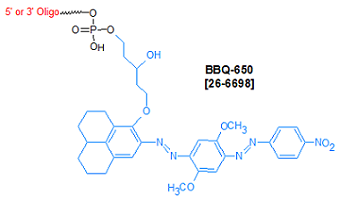
Modification : 5'-BBQ-650
Catalog Reference Number
Category
Modification Code
5 Prime
3 Prime
Internal
Molecular Weight (mw)
Extinction Coeficient (ec)
Technical Info (pdf)
Absorbance MAX
Emission MAX
Absorbance EC
26-6696
Quenchers
[BBQ-650-5]
Y
N
N
667.63
-
PS26-6696.pdf
650
-
-
| Catalog No | Scale | Price |
| 26-6696-05 | 50 nmol | $425.00 |
| 26-6696-02 | 200 nmol | $425.00 |
| 26-6696-01 | 1 umol | $481.00 |
| 26-6696-03 | 2 umol | $679.00 |
| 26-6696-06 | 5 umol | $2,164.50 |
| 26-6696-10 | 10 umol | $3,406.00 |
| Discounts are available for 5'-BBQ-650! |
| Modification* Discount Price Structure |
|
1 site/order
|
List price
|
|
2 sites/order
|
10% discount
|
|
3 sites/order
|
20% discount
|
|
4 sites/order
|
30% discount
|
|
5-9 sites/order
|
50% discount
|
|
10+ sites/order
|
60% discount
|
|
*Exceptions apply
|
BlackBerry Quencher 650 (BBQ650) is classified as a dark quencher (a non-fluorescent chromophore). Dark quenchers are extensively used as the 3'-quencher moiety in a variety of Fluorescence Resonance Energy Transfer (FRET) DNA detection probes in which the fluorophore has a long wavelength (yellow to far red) emission maximum (e.g. Cy3, ROX, Cy5, Cy 5.5). Dark quenchers can serve in this role because they have long wavelength absorbance maxima. Dark quenchers are primarily used in nucleic acid assays, but also find a place in nucleic acid structural studies (1). Examples include TaqMan probes (2), Scorpion primers (3), and Molecular Beacons (4).
BBQ650 has an absorbance maximum of 650 nm, and an effective absorbance range of 550-750 nm (yellow to far red). It is chemically resistant to both oligonucleotide synthesis reagents (iodine, TCA) or deblocking solutions (ammonia, AMA). Consequently, for synthesis of longer oligos (> 50 bases), BBQ650 is the preferred quencher over BHQ-2 or BHQ-3, as the latter are chemically less stable, and degrade when exposed to oligo synthesis and deprotection conditions for long periods of time, such as when synthesizing or processing longer oligos.
A list of specific fluorescent dyes compatible with BBQ650 is found at this link.
Click here for complete list of quenchers
The emission spectra of this set of dyes sufficiently overlaps the absorbance spectrum of BBQ650 to allow the latter to quench the fluorescence of the former with a high degree of efficiency.
The advantages of using BBQ650 as a dark quencher in a FRET probe are (a) low background fluorescence (and thus better signal-to-noise ratio), (b) higher dynamic range, (c) amenability to multiplex assays (due to a dark quencher having no secondary fluorescence), and (d) ease of synthesis of FRET probes (due to BBQ650 being resistant to degradation during the oligo deprotection step).
<
Click here for list of quenchers.
Click here for a list of fluorophores.
|
Quencher Spectral Data
|
|
Quencher
|
Absorption Max, nm
|
Quenching Range, nm
|
| Dabcyl |
453 |
380-530 |
| BHQ-0 |
495 |
430-520 |
| BHQ1 |
534 |
480-580 |
| BHQ2 |
579 |
550-650 |
| BHQ3 |
672 |
620-730 |
| BBQ-650 |
650 |
550-750 |
|
Click here for complete list of quenchers and details
|
**Black Hole Quencher License Agreement
Black Hole Quencher License Agreement.
"Black Hole Quencher®, BHQ®, CAL Fluor® and Quasar® are registered trademarks of
Biosearch Technologies, Inc., Petaluma, California.
The BHQ, CAL Fluor and Quasar dye technologies are protected by U.S. and world-wide patents either issued or in application. Compounds
incorporating these dyes are made and sold under agreement with Biosearch Technologies, Inc. for end-user's non-commercial research and development use only.
Their use in commercial applications is encouraged but requires a separate Commercial Use License granted by Biosearch Technologies, Inc."
|
References
1. Didenko, V.V. DNA Probes Using Fluorescence Resonance Energy Transfer (FRET): Designs and Applications. Biotechniques (2001), 31: 1106-1121.
2. Livak, K.J., Flood, S.J.A., Marmaro, J., Giusti, W., Deetz, K. Oligonucleotides with fluorescent dyes at opposite ends provide a quenched probe system useful for detecting PCR product and nucleic acid hybridization.PCR Methods Appl. (1995), 4: 1-6.
3. Thelwell, N., Millington, S., Solinas, A., Booth, J., Brown, T. Mode of action and application of Scorpion primers to mutation detection. Nucleic Acids Res. (2000), 28: 3752-3761.
4. Tyagi, S., Kramer, F.R. Molecular beacons: probes that fluoresce upon hybridization. Nat. Biotechnol. (1996), 14: 303-308.
- BBQ-650 5' (Black Berry Quencher 650 5')
